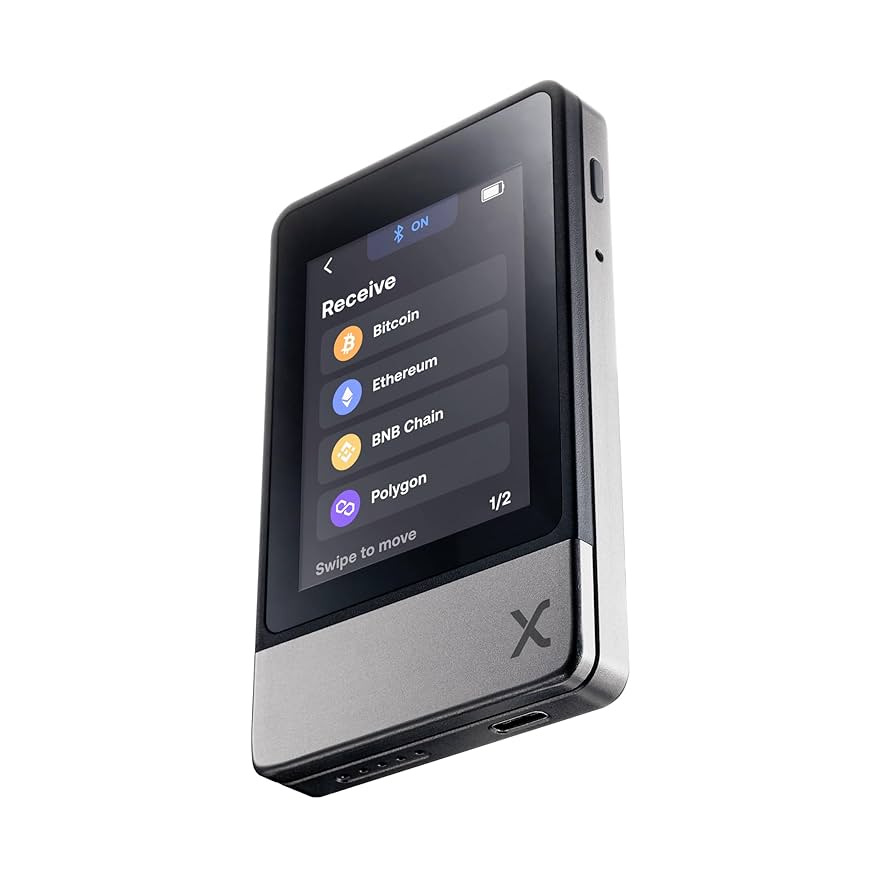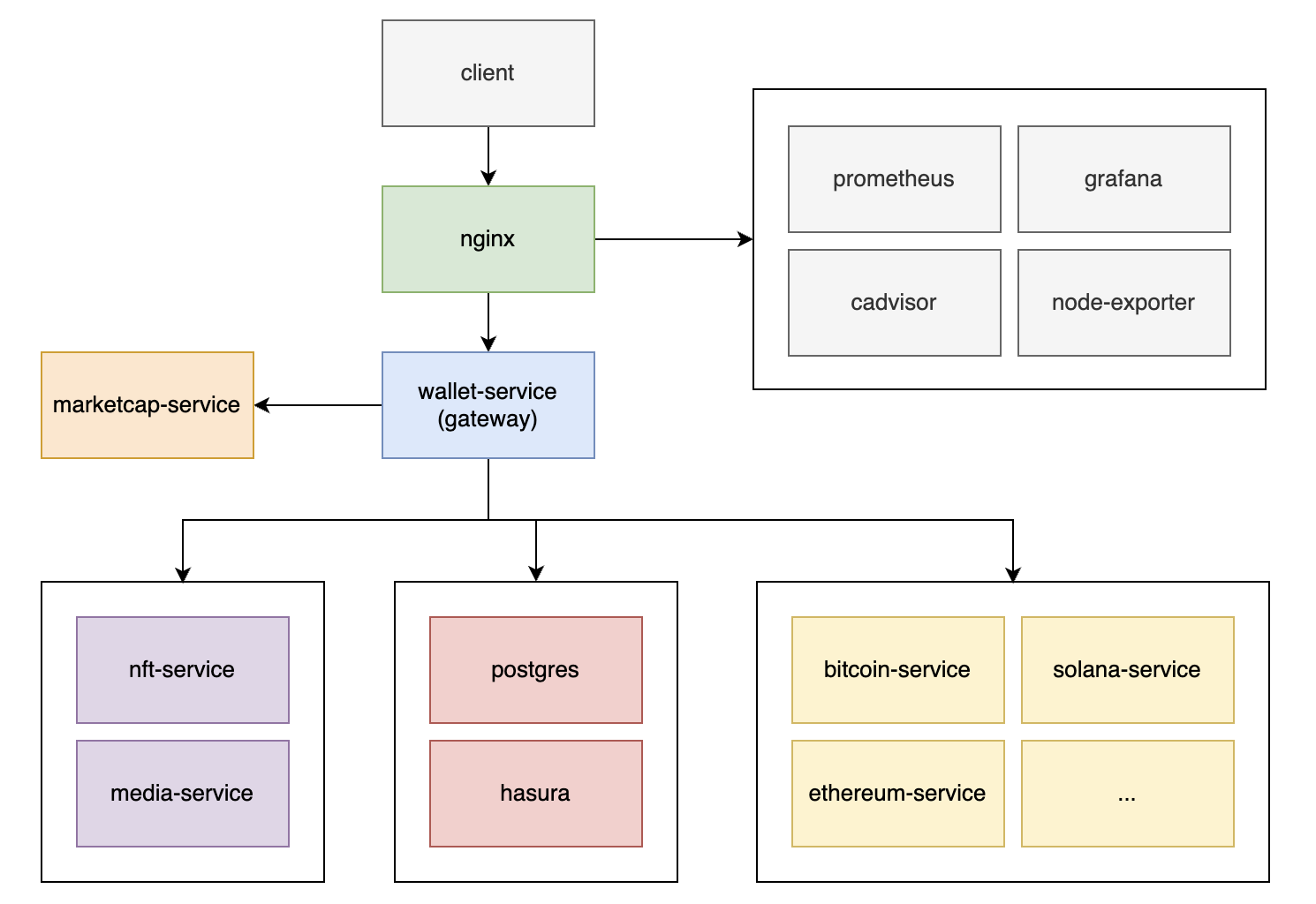Building Blockchain Infrastructure at SecuX
After leaving PSI, I joined SecuX — one of Taiwan's largest blockchain startups — seeking B2C impact, startup ownership, and blockchain industry experience. I worked across three core areas: backend microservices for cold wallets, a multi-provider swap service, and decentralized identity (DID) applications.
This post covers the technical architecture, challenges, and solutions across these three domains.
Backend Microservices
Cold Wallet Architecture
Cold wallets store private keys on-device and sign transactions locally. The mobile/desktop app handles balance tracking, transaction building, and network communication via our backend services.
 Figure 1: Code wallet example (SecuX Neo X)
Figure 1: Code wallet example (SecuX Neo X)
Tech Stack
Node.js microservices on Google Cloud Platform with Cloudflare → Nginx → services. Socket.IO for real-time client updates, REST for inter-service communication, Postgres + Hasura for data, Docker Compose for deployment, Prometheus/Grafana for monitoring.
Service Architecture
- Core Services: Wallet Service (gateway/orchestration), Marketcap Service (prices/FX rates)
- Chain Services: One per blockchain (Bitcoin, Ethereum, Solana, etc.) with normalized APIs for balance, fees, transactions
- Data Layer: Postgres DB Service + Hasura GraphQL
- Support Services: NFT metadata, media caching, scheduled jobs, monitoring
 Figure 2: Backend microservices overview
Figure 2: Backend microservices overview
The modular design allows adding new blockchains without modifying existing services.
Transaction Flow Example
- Metadata refresh: Background jobs keep prices, fees, and token info cached
- Account state: Fetch balance/nonce from cache or live blockchain data
- Build transaction: Assemble unsigned transaction with gas simulation and price data
- Sign: Hardware wallet signs transaction locally (private key never leaves device)
- Broadcast: Submit to network with idempotency protection
- Track: Monitor confirmation status with real-time client updates
My Contributions
I joined when the backend was new and limited, tasked with expanding capabilities and improving performance across more networks and assets.
Key Improvements
Wallet Service Optimization
Refactored monolithic sync APIs into async flows with caching for hot data.
- Result: 50% lower overhead, ~20× throughput improvement, sub-second balance refreshes
Marketcap Service Overhaul
Replaced lazy updates with eager refreshes and unified asset mapping.
- Result: Removed ⅔ duplicate metadata, cleaner dataset, better coverage analysis
Chain Services Expansion
Handled three major complexity areas:
- Provider reliability: Health checks, timeouts, retries, failover for external RPC providers
- Chain quirks: Normalized different blockchain behaviors (nonces, fees, confirmations) into unified APIs
- Fee estimation: Optimized for confirmation reliability while minimizing costs across UTXO, EVM, and L2 chains
Scaling Framework
Built lightweight v2 framework with standardized structure and testing.
- Result: Tripled supported networks with faster, more reliable expansion
Monitoring Infrastructure
Implemented Prometheus + Grafana with centralized dashboard for the entire team.
- Result: Eliminated SSH debugging, provided real-time visibility into system health
Swap Service
Our first SaaS offering: aggregating multiple swap providers (centralized + decentralized) to route users to the best deals while handling gas, data enrichment, and transaction broadcasting.
Architecture Challenges
- Cross-chain complexity: Unlike same-chain swaps (one transaction), cross-chain requires coordinating two separate legs with bridge settlement tracking
- Provider normalization: Designed universal interface to handle very different provider APIs and fee structures
- Asset mapping: Blockchain asset names are inconsistent — solved with AI-powered mapping using Gemini to generate structured outputs
Core Components
- Provider management: Registry of supported swap services
- Asset registry: Canonical symbols, decimals, metadata
- Provider-specific mappings: What each service actually supports
- Order tracking: User-level swap history and status
 Figure 3: Swap service database overview. We use cron jobs calling provider APIs, then process and store asset data according to our own schema
Figure 3: Swap service database overview. We use cron jobs calling provider APIs, then process and store asset data according to our own schema
AI-Powered Solution
Instead of maintaining massive mapping tables or fuzzy matching, I used Gemini with grounding for real-time asset mapping. When encountering new tokens (common in EVM "lazy support"), the system generates structured mappings, saves to DB, and treats as permanent records.
Impact: First SaaS offering driving tens of thousands in monthly revenue with minimal effort to add new providers and assets.
Decentralized Identity (DID)
A bet on a new business model — exploring blockchain-native identity solutions as an alternative to traditional third-party verification systems.
Concept
DID works like a verifiable receipt: instead of storing records in company databases or paying third parties for verification, you anchor cryptographic proofs on-chain. This enables passwordless login, user-controlled data sharing, and cheaper compliance.
Implementation Approaches
- NFT identity passes: Simple ownership-based access (own the NFT, get access)
- W3C DID standard: Formal spec with on-chain identifier resolution backed by hardware wallet security
 Figure 4: DID example and workflow
Figure 4: DID example and workflow
My Role
Application design: Joined partner calls to explore DID integration possibilities, sketched system designs for removing third-party verifiers, and explored integration with account abstraction and web-based blockchain login.
DevOps & operations: Set up partner environments, built testing flows, wrote documentation, and debugged cross-organizational integrations.
Impact: Established credible DID capabilities with working implementations and clear value proposition for partners.
Reflection
SecuX provided the perfect combination of real product impact, startup ownership, and deep blockchain experience. From optimizing core wallet infrastructure to launching SaaS offerings to exploring cutting-edge identity solutions, the role pulled me deeper into the blockchain ecosystem while developing both technical and business skills.
The startup environment fostered ownership, flexibility, and meaningful work — along with a team passionate about crypto markets, blockchain tech, and AI breakthroughs. This experience shaped my career intentionality and provided lasting friendships and invaluable learning opportunities.